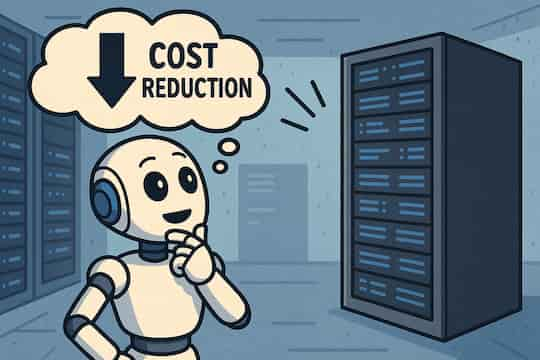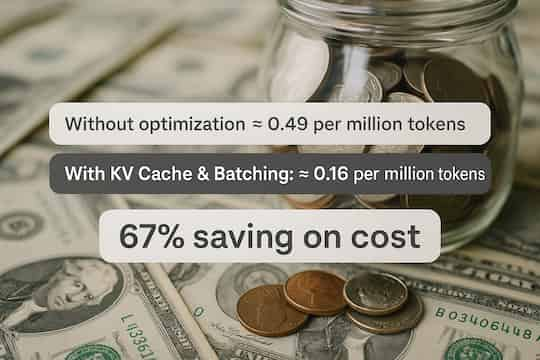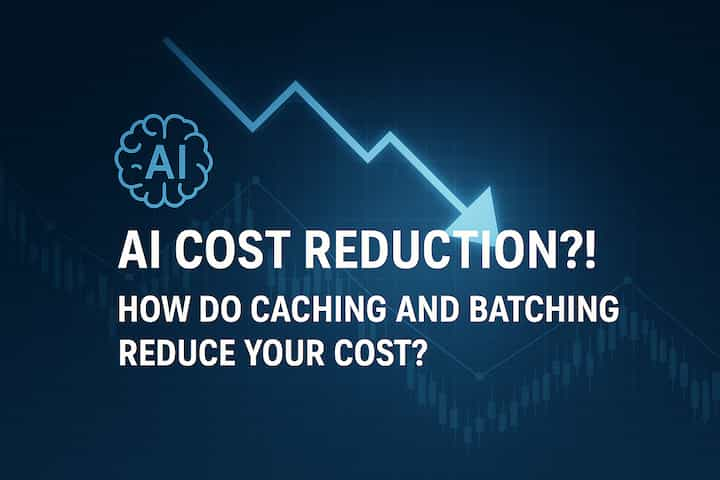LLM Cost Reduction - KV Caching + Batching = 67% Savings
Hello!! Founders and Technical Heads
Let us talk why do we need to introduce KV caching in our models?
Technical jargon like "KV cache" translates into real-world cost savings for your LLM deployments.
#LLMs are very expensive
LLMs are designed to be "autistic," meaning they generate one word or token at a time. To figure out the next word, they need to re-read everything they've already said i.e. the prompt plus all generated words so far. This re-reading is incredibly expensive. Imagine you have a team of highly paid experts (in this case - your LLMs). Every time you ask them a question and they generate tokens, they're doing a lot of complex calculations.
Let's break it down in easy-to-understand terms, using actual GPU/TPU costs and showing how batching also plays a big role.
How does the Smart Memory Aid - KV cache help?
Think of KV cache as a super-efficient memory assistant for your LLM. Instead of re-reading everything from scratches each time, the assistant takes notes. These notes are the "Key" and "Value" information about each word.
- First Question (Prompt you write): When you give the LLM its initial prompt (e.g., "Summarize this article: [long article text]"), it reads the article and takes detailed notes for every word. These notes are stored in its "KV cache."
- Generating the Answer (Token by Token): Now, when the LLM starts writing the summary, it writes the first word. To write the second word, it doesn't re-read the entire article and the first word. Instead, it just looks at its new thoughts for the second word and combines them with the KV cache notes it already took from the article and the first word. It then adds notes for the second word to the cache. This process continues, always referring to the cached notes rather than re-reading everything.
This speeds up the thinking process and repeat process is eliminated and the past information is instantly accessible.
How Batching Ensures Savings
Now, imagine you have a queue of questions for your expert team.
- No Batching: You give one question to one expert. They work on it, finish, and then you give the next question to the next available expert. This is inefficient.
- Batching: You collect several questions in a batch and give them to your LLMs. Even better, with Continuous Batching, as soon as an expert finishes one part of a question, they immediately pick up the next available piece of work, rather than waiting for an entire question to be completed.
Batching makes sure your expensive GPUs/TPUs are always busy. They're not sitting idle waiting for the next single question. This significantly increases the number of responses you can get out of your hardware in the same amount of time.
KV Cache + Batching = Massive Cost Reduction
When you combine KV caching with effective batching:
- KV Cache makes each individual process - generating a token - much faster by eliminating redundant re-calculations.
- Batching ensures that your expensive hardware is always fully utilized, processing many tokens for different requests in parallel.
This synergy allows you to serve many more customer requests with the same amount of high cost hardware, or achieve the same workload with significantly less hardware.

Quantifying the Savings: Actual Costs & Examples
Let's use some real-world cloud GPU/TPU costs. As of mid-2025:
- NVIDIA H100 GPU: A top-tier GPU, often rented in the cloud for around $3.00 - $4.00 per hour.
- Google Cloud TPU v5p: A powerful specialized chip for AI, costing about $4.20 per hour per chip.
Let's take an average figure of $3.50 per hour for a high-end AI accelerator.
Now--🡪 Imagine your LLM service needs to generate 1,000,000 tokens (roughly 700,000 words) per hour for your users.
1. Cost WITHOUT KV Cache or Optimized Batching (The "Expensive" Way):
Without KV caching, each token takes significantly longer to generate because of all the re-computation. Plus, if you're not batching efficiently, your GPU/TPU sits idle between requests or processes very few requests at once.
- Impact: Throughput (tokens per second) is low. Let's say, very conservatively, you can only generate 2,000 tokens per second on one GPU/TPU in this unoptimized scenario
- Hourly Output:
2,000 tokens/sec × 3600 sec/hour = 7,200,000 tokens/hour per GPU
- GPUs Needed for 1M tokens/hour target:
(1,000,000 tokens/hour) / (7,200,000 tokens/hour/GPU) ≈ 0.14 GPUs
(so we will need 1 GPU for practical purposes).
- Cost:
GPU × $3.50/hour = $3.50 per hour for 7.2M tokens/hour.
Cost per 1 million Tokens: ($ 3.50 / 7.2 million tokens) ×1 million tokens = $0.49
Now here comes the concept of utilisation.
If your model isn't being hit constantly with requests, the GPU will be idle. Without batching, processing 1M tokens might mean lots of idle time. The real cost comes from how many GPUs you need to run to meet peak demand with high latency.
Let's re-frame to focus on how much faster we can process a given amount of work.
2. The Impact of KV Cache & Batching (The "Smart" Way)
Research and industry reports consistently show that with effective KV caching and advanced batching techniques (like Paged Attention and continuous batching), you can achieve 2x to 5x or even higher throughput improvements for LLM inference. Let's take a realistic, conservative average improvement: 3x higher throughput.
- Improved Throughput per GPU: 2,000 tokens/sec × 3 = 6,000 tokens/sec
- New Hourly Output:
6,000 tokens/sec×3600 sec/hour = 21,600,000 tokens/hour per GPU.
Now, let's see how this affects the cost for our target of generating 1,000,000 tokens per hour:
- GPUs Needed for 1M tokens/hour target:
(1,000,000 tokens/hour) / (21,600,000 tokens/hour/GPU)
≈ 0.046 GPUs (still 1 GPU in practice, but it's working much more
efficiently).
- Cost:
1 GPU × $3.50/hour = $3.50 per hour for 21.6M tokens/hour.
Cost per 1 Million Tokens: ($3.50/21.6 million tokens) × 1 million tokens ≈ $0.16
Comparing the Cost Per Million Tokens
- Without optimization (Hypothetical): ≈ $0.49 per million tokens
- With KV Cache & Batching: ≈ $0.16 per million tokens
Percentage Cost Saved:
Savings Percentage = ($0.49 − $0.16) / $0.49 × 100% = 67.3%

What Does This Mean for Your Business?
- Significant Cost Reduction: By implementing KV caching and smart batching, you can expect to cut your LLM inference infrastructure costs by over 60% for the same workload. For a business spending, say, $100,000 a month on LLM inference, that's over $60,000 in monthly savings!
- Increased Capacity: Alternatively, with the same hardware budget, you can serve 3 times more customer requests, expanding your reach and revenue potential without proportional increase in spending.
- Better User Experience: Faster token generation also means lower latency, providing quicker responses to your users and improving their overall experience. This can lead to higher engagement and satisfaction.
- Sustainable Scaling: As your LLM usage grows, these optimizations allow you to scale your operations more sustainably, delaying the need for costly hardware upgrades.
KV caching, coupled with intelligent batching strategies, is not just a technical detail; it's a strategic imperative for any organization deploying LLMs. It directly translates into a more efficient, cost-effective, and performant AI system, giving you a competitive edge in the rapidly evolving AI landscape. Investing in these optimizations is investing in the future growth and profitability.
For AI consultancy and deployment in your business, you can contact us - contact@aimlverse.com
